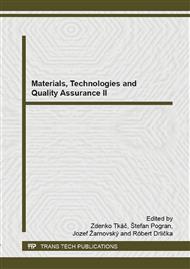[1]
J. N. Landers, P. L. de Freitas, Zero tillage cotton systems and soil quality, in: EGU General Assembly 2012, held 22–27 April, 2012 in Vienna, Austria, information on http: /adsabs. harvard. edu/abs/2012EGUGA. 1413723L.
Google Scholar
[2]
D. Hillel, Environmental soil physics, Academic Press, Division of Harcourt Brace and Company San Diego, CA, USA, (1998).
Google Scholar
[3]
R. L. Raper, D. W. Reeves, Reducing soil compaction with in-row subsoiling and controlled traffic, in: Proceedings of Session IV of the 2004 CIGR International Conference October, Beijing, China, 2004a.
Google Scholar
[4]
R. L. Raper, Vehicle traffic impacts on soil, Terramechanics Journal, 42(3–4) (2005) 259–280.
DOI: 10.1016/j.jterra.2004.10.010
Google Scholar
[5]
ASAE Standards, 45th ed., EP291. 2, Terminology and definitions for soil tillage and soil-tool relationships, ASAE, St. Joseph, Michigan, (1999).
Google Scholar
[6]
H. M. Taylor, H. R. Gardner, Penetration of cotton seedlings taproots as influenced by bulk density, moisture content and strength of soil, Soil Science, 96 (1963) 153–156.
DOI: 10.1097/00010694-196309000-00001
Google Scholar
[7]
ASAE Standards, 50th ed., EP542, Procedures for using and reporting data obtained with the soil cone penetrometer, ASAE, St. Joseph, Michigan, 2004a.
Google Scholar
[8]
M. A. Hamza, W. K. Anderson, Soil compaction in cropping systems: A review of the nature, causes and possible solutions, Soil Tillage Research, 82 (2005) 121–145.
DOI: 10.1016/j.still.2004.08.009
Google Scholar
[10]
K. Fiala, J. Kobza, Ľ. Matúšková, V. Brečková, J. Makovníková, G. Barančíková, V. Búrik, T. Litavec, B. Houšková, A. Chromaničová, D. Váradiová, B. Pechová, Záväzné metódy rozborov pôd. Čiastkový monitorovací systém – pôda, VÚPOP, Bratislava, (1999).
Google Scholar
[11]
STN 72 1012: Laboratórne stanovenie vlhkosti pôd. (Slovak technical standard: Determination of soil moisture in laboratory conditions).
Google Scholar
[12]
Zákon č. 220/2004 Z. z. o ochrane a využívaní poľnohospodárskej pôdy a o zmene zákona č. 245/2003 Z. z. o integrovanej prevencii a kontrole znečisťovania životného prostredia a o zmene a doplnení niektorých zákonov. (Slovak Act No 220/2004 on Protection and Use of Agricultural Land).
Google Scholar
[13]
J. K. Berry, The precision farming primer, Berry & Associates / Spatial Information Systems Inc., Fort Collins, Colorado, USA, 1999, information on http: /www. innovativegis. com/basis/pfprimer/Default. html.
Google Scholar
[14]
D. Rooney, M. Stelford, D. Landolt, Site-specific soil compaction mapping using a digital penetrometer, Site-specific management guidelines SSMG-34, Potash & Phosphate Institute (PPI), undated.
Google Scholar
[15]
K. Kollárová, J. Ďuďák, M. Žitňák, J. Simoník, Prescribing a tillage depth based on geo-referenced soil compaction, Acta Technologica Agriculturae, 12(3) (2009) 71–76.
Google Scholar
[16]
M. Žitňák, M. Korenko, Technical-economic indicators in the sugar beet transportation management, Research in Agricultural Engineering, 57(2) (2011) S63–S71.
DOI: 10.17221/29/2010-rae
Google Scholar


